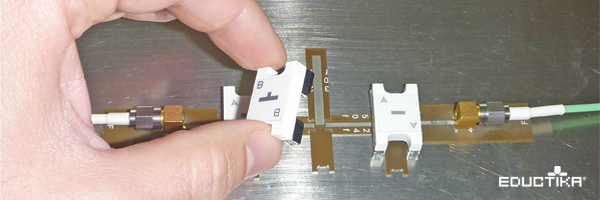Microwave Teaching Kits based on a “puzzle” concept
For teaching staff and students, Eductika devises the microwave education kit. Eductika lets you build microwave functions with ease thanks to basic puzzle elements. The kits are full of possibilities. Let your imagination and creation flow.
Context

The development of new applications and new uses in telecommunications has contributed to increase the Wireless related activities, especially in the microwave field. In electronics, this topic constitutes a unique job for which the mastery of not only wave-guided propagation, lumped elements, distributed elements, wavelength concepts, but also of planar and volume technologies is a must.

This is why Elliptika has developed a training kit, Eductika. It is dedicated to students in electronics and the teaching staff. The scope of the training kits are microstrip devices (passive, active and antennas). Eductika allows one to build either entirely, or partially, microwave functions from basic puzzle elements. This very complete puzzle game consists of microstrip line sections identified from their impedance and length, and linked on a magnetic plate by a connecting item.
Elliptika has designed Eductika Kits to help you and your students to familiarize and stay up to date with technologies important to your future or current job. Our kits focus on the practical aspects of microwaves. We create practicals in the labs that are as close as practical to real life applications to enhance the learning experience.
A practical session: from design to measurement
The education kit, Eductika, is composed of basic sub-sets of microwave passive components aimed at teaching students the fundamentals of microwaves. It offers to acquire, through practice, skills in various subjects, i.e. the physics of microstrip lines, impedance matching devices, conduct of measurement and synthesis of elementary functions (coupler, power divider, band- and low-pass filters, SC and OC stub filter,..) as well as some passive functions of higher complexity and based on these elementary functions. In this way, the students will not only become familiar with conventional microwave devices developed in planar technology but also learn about mathematical synthesis tools, CAD simulation tools and issues in relation with the measurement of these devices.
Families
Passive Devices
•This solution is designed for students so they can learn about passive components such as resonators, filters, power dividers and couplers.
•6 Lab Work Guides
Antennas
•This solution is designed to familiarize students with antennas and their measurement.
•4 Lab Work Guides
•Antenna Measurement System
Active Devices
•This solution is designed for students so they can understand and experience the active component behavior.
•4 Lab Work Guides
Modern technology for RF and microwave integrated circuits (ICs) provides smaller size,lighter weight, and lower cost.
Passive components play a key role in RF designs for performance matching, tuning,filtering, and biasing. Passive components are prevalent in RF and microwave IC. For example, it is estimated that in a single-mode wireless phone, passive components account for 90% of the component count, 80% of the size, and 70% of the cost [1] RF and microwave ICs are usually based on these passive printed components: directional couplers, baluns, power dividers/combiners, filters, phase shifters, ferrite isolators/circulators, and duplexers. In this paper we will consider the essential for passive printed RF and microwave components using microstrip technology process.
Active microwave devices perform a variety of key functions, including the transformation of DC current to RF current (oscillation), the conversion of a signal at one frequency to another (multiplication, mixing), the redirection of a signal (switching), and the intensification and replication of a signal (amplification). Of the large variety of active microwave devices in use, we focus here on the bipolar and field effect transistor.
Antennas are basic components of any electric system and are connecting links between the transmitter and free space or free space and the receiver. Thus antennas play very important role in finding the characteristics of the system in which antennas are employed. Antennas areemployed in different systems in different forms. Here, we will focus on patch antennas. Put simply, the antenna is a device for transmitting and/or receiving signals - the eyes and ears of your communication system. A good antenna is designed to be "in-tune" to the signal you are seeking - your phone or radio "sees" the signal and you hear a clear conversation. Use a poor antenna and you're simply not going to get your call through.
Key benefits
Who can benefit from Eductika?
• Professor, teacher, student, academic staff member, administrator, technician, engineer from
•Universities, technical institutes, schools of engineering, colleges, and research institutions
•Vocational, Industrial Training
•Companies
